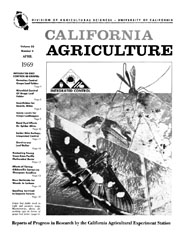


University of California
California Agriculture
|
|||
|
|||

Cover:
Grape leaf folder moth to right and parasitic wasp, Macrocentrus, above, depositing eggs in larvae of grape leaf folder.
April 1969
Volume 23, Number 4 |
|||
|
University of California, 1301 S. 46th St., Bldg. 478 Richmond, CA
|